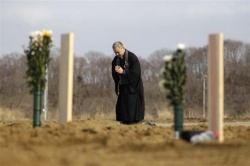Kesa
Kesa ; Buddhist surplice. Sk. Kāshāya. A brocade robe worn over the left shoulder by members of the Zen school. A much smaller version, a square
apron hung from the neck, is known as the rakusa, and can also be worn by laymen. In daily conversation this smaller garment is often referred to as a kesa.
All these garments are worn over the koromo (q.v.) which may vary with the Bst. school.
A general term for an outer garment worn by Buddhist priests and found on Buddhist figures.
The kesa originated in India, and its name is derived from the Sanskrit kasaya, meaning 'dark-coloured'.
In India, priests' robes were always made from dyed cloth, whilst laymen wore white. Originally, the kesa was made by piecing together rags.
However, in China and Japan where temperatures are much lower, undergarments were worn beneath the kesa, and it soon came to be used as a formal ornament.
Later, fine fabrics such as *kinran 金襴 (gold brocade) and *nishiki 錦 (patterned weave fabrics) were used to make the kesa.
Several narrow strips of fabric are sewn together to form a rectangular cloth, which is usually draped over the left shoulder and under the right arm *hentan uken 偏袒右肩.
The kesa has various types distinguished by the number of strips of fabric used.
The gojougesa 五条袈裟 has five strips, the shichijougesa 七条袈裟 has seven strips, and so on.
Many Japanese Buddhist sects developed their own distinctive style of kesa.
